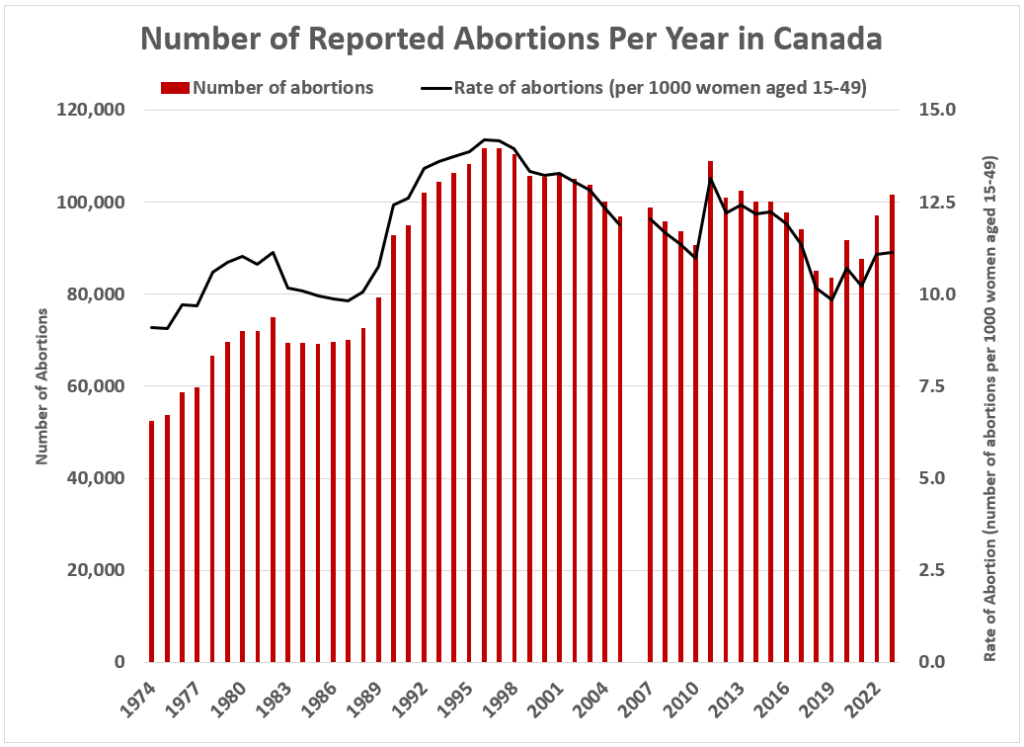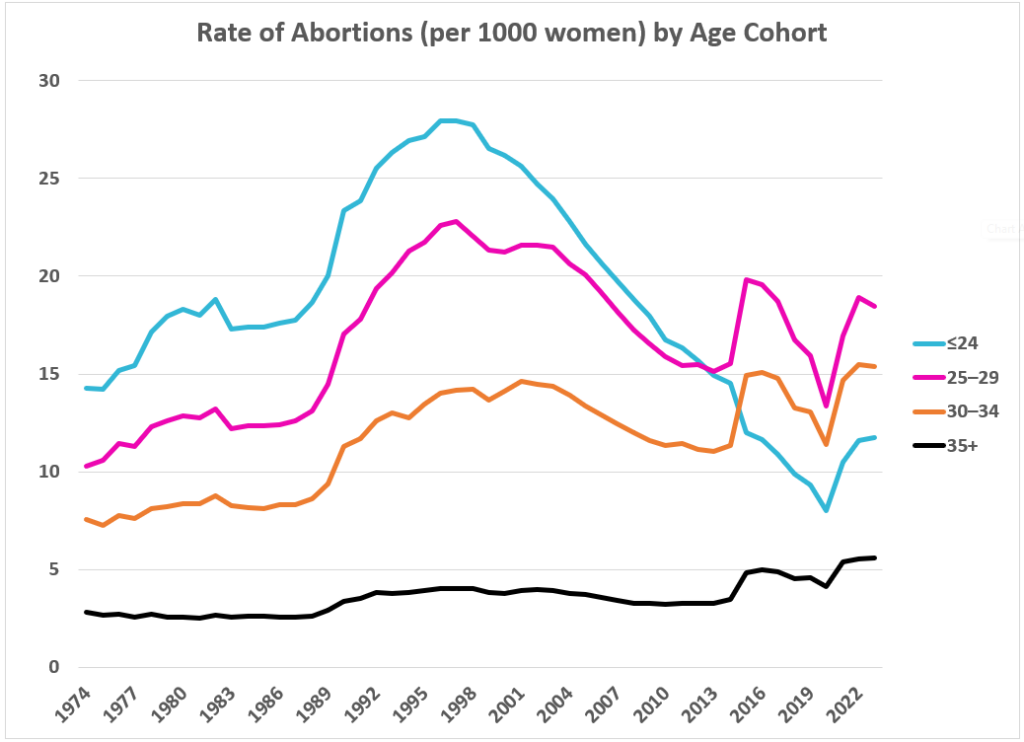The reported abortion rate in Canada is the highest it has been in almost a decade. Let’s take a look at what these numbers mean as we see again the need for change in Canada – change of hearts, minds, and laws on the issue of pre-born human rights.
On March 20, 2025, the Canadian Institute for Health Information (CIHI) released its annual abortion data. This data gives information through the end of 2023. The number of reported abortions rose from 97,211 in 2022 to 101,553 in 2023, marking the first time in eight years that the number of abortions topped 100,000 and becoming the highest figure in the past ten years. The number of abortions peaked in 1997 and the 2023 stats are only the fourth time since that the number of abortions has risen (excluding 2011 and 2020 when CIHI adjusted its methodology and 2006 where there is no data reported).
Over the past 50 years, the rate of abortion in Canada grew from 9.1 abortions per 1000 women aged 15-49 in 1974 to 14.2 in 1996 and slowly declined to 11.1 in 2023.

The overall decline in the number and rate of abortions has stalled. 2019 saw the lowest number of reported abortions (83,576) since 1989 (79,315), the first full year after the Morgentaler decision struck down Canada’s law on abortion. In fact, the rate of abortion was lower in 2019 (9.8 abortions per 1000 women aged 15-49) than any time since 1977. But in the last few years, the number and rate of abortion has begun to increase again.
What’s driving this increase?
One reason for increases in the number of abortions in some years is growth in the Canadian population. For example, even though the number of abortions increased by over 4,000 from 2022 to 2023, the overall rate of abortion stayed essentially the same. If the number of Canadian women of child-bearing age grows (and that number grew by almost 400,000 between 2022 and 2023), then the number of abortions can be expected to grow, everything else remaining equal. However, the Canadian population has grown almost every since year since the number of abortions peaked in 1997, so there must be something more behind the recent increase in the rate of abortion.
Another reason for this increase is simply methodological. In 2011 and 2020, CIHI adjusted its methodology in how it reports abortion. This change in methodology ensures more accurate abortion reporting and caught thousands of abortions that were missed in the counts before. And so, the number of official abortions spiked those years, but it is likely that a similar number of abortions actually happened in the preceding years. However, there were no changes to how the number of abortions were counted in 2022 and 2023, two years where the number increased.
A third possible reason for the recent uptick in abortion could be the economic turmoil of recent years. Facing lockdowns that forced many people to lose their jobs, a pandemic that made many people fearful for their health (and the health of a new baby), and the surge in inflation in the last few years, many Canadians may have decided that recent years were simply not the right years to have a child. Perhaps children are seen as too expensive. And so, when facing an unplanned pregnancy, more Canadians have chosen to abort.
What else does the abortion data tell us?
First, the rate of abortion varies across the country. The more rural and less populated parts of Canada – the Maritime provinces and Saskatchewan – have the lowest rates of abortion. Quebec, Ontario, and Manitoba have the highest rates of abortion. Since 2019, the recent low point of abortion, the rate of abortion has increased in every province – led by Ontario and New Brunswick – and only decreased in two provinces – Quebec and Alberta.
Second, the age of women who are aborting their children is changing. Women aged 25-29 are the most likely to have an abortion (18.4 abortions per 1000 women). They are closely followed by women aged 30-34 (15.4 abortions per 1000 women) and aged 18-24 (14.9 abortions per 1000 women). The rate of abortion for women aged 35+ is only 5.6 abortions per 1000 women. Girls aged 15-17 have the lowest rate of abortion at 3.3 abortions per 1000 women. This has changed over the years. Until about 2013, women below the age of 25 were the most likely to have an abortion. This became the stereotype of a young woman in high school or college or just starting a job choosing to have an abortion. But the rate of abortion for these young women is now about half of what it was 20 years ago. The rate of abortion has declined only slightly for women aged 25-29 in that time period (18.4 vs 21.6 abortions per 1000 women) and actually grown for women over the age of 35 (5.6 vs 3.9 abortions per 1000 women).

Where abortion is provided has also changed. In 2008, 46.3% of all abortions happened in a hospital and 53.7% occurred in a non-hospital setting, generally specialized abortion clinics. In 2023, only 20.8% of abortions happen in a hospital with the remaining 79.2% occur outside of hospitals. That is a big shift towards specialized abortion clinics and at-home abortions with abortion pills.
A big reason for this is that abortions are increasingly being done medically, rather than surgically. CIHI doesn’t have consistent data going very far back for the method of abortion but, in just the last two years, the percentage of abortions done surgically fell by 4.5% and the percentage done medically (through, for example, the abortion pill) has increased commensurately. With 58.7% of all abortions being done surgically and 41.3% using medication in 2023, it is likely that in a few years medical abortion will be the dominant form of abortion in the reported statistics.
Conclusion
It is hard to see abortion numbers rising. This means more women are facing pregnancy with fear and a lack of support. It means our pro-abortion federal and provincial governments have successfully sold the lies that abortion is a necessity, or a right, or part of health care. Abortion is none of these things. It is the deliberate killing of a vulnerable pre-born child in what should be one of the safest places in the world.
There is much work to be done to educate the public on the humanity of pre-born children, and the right to life that should come with that. Too many women have bought the lie that children are a burden, a limitation, and ultimately expendable. Together, the pro-life movement in Canada must continue to speak up for those who cannot speak for themselves, until they have equal protection under the law and these numbers can do nothing but drop.